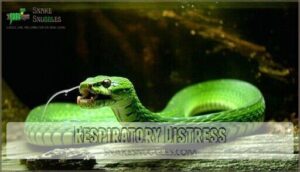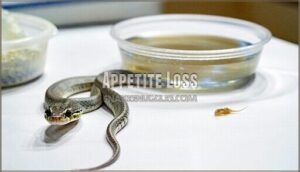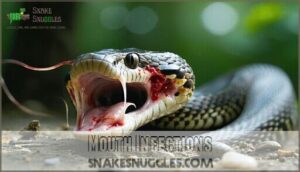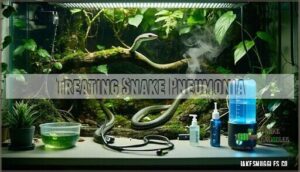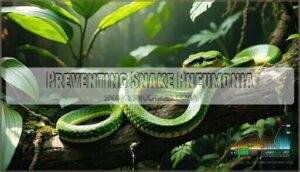This site is supported by our readers. We may earn a commission, at no cost to you, if you purchase through links.
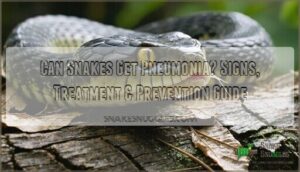
This respiratory infection hits your scaly friend hard, causing labored breathing, wheezing, and that telltale mouth-breathing posture.
You’ll notice your snake losing its appetite, becoming lethargic, and possibly developing mouth rot alongside the breathing troubles.
Bacterial infections are the usual culprits, though poor husbandry conditions like incorrect temperatures or humidity levels often set the stage, making you think of it as your snake’s lungs getting clogged up, much like when you’re fighting a nasty chest cold.
The good news is that catching it early makes all the difference in treatment success and recovery outcomes, which is why early detection is crucial for your snake’s health, emphasizing the importance of correct temperatures and humidity levels.
Table Of Contents
- Key Takeaways
- Can Snakes Get Pneumonia?
- Symptoms of Snake Pneumonia
- Diagnosing Snake Pneumonia
- Stages of Snake Pneumonia
- Treating Snake Pneumonia
- Preventing Snake Pneumonia
- Animals Affected by Pneumonia
- Frequently Asked Questions (FAQs)
- How do I know if my snake has pneumonia?
- How do you treat pneumonia in snakes?
- Can reptiles get pneumonia?
- What animals does pneumonia infect?
- What are the long-term effects of pneumonia on a snakes health?
- How common is snake pneumonia?
- Are some snake species more at risk?
- Can snake pneumonia be prevented with vaccines?
- What is the prognosis for snakes with pneumonia?
- How long does snake pneumonia treatment take?
- Conclusion
Key Takeaways
- Yes, your snake can get pneumonia – It’s a serious respiratory infection caused by bacteria, viruses, fungi, or parasites, often triggered by poor husbandry conditions like incorrect temperature or humidity levels.
- Watch for telltale symptoms – You’ll notice open-mouth breathing, gurgling sounds, nasal discharge, head elevation while resting, appetite loss, and lethargy that signal your snake needs immediate veterinary attention.
- Early detection saves lives – Catching pneumonia in Stage 1 gives you the best chance for successful treatment, while Stage 3 becomes life-threatening and requires emergency intervention.
- Prevention beats treatment – You can avoid pneumonia by maintaining proper temperature gradients, humidity levels, quarantining new snakes for 90 days, and ensuring regular vet checkups with good enclosure hygiene.
Can Snakes Get Pneumonia?
Yes, your snake can develop pneumonia, a serious respiratory infection affecting their lungs and breathing passages.
Snake pneumonia stems from bacterial, viral, fungal, or parasitic causes, often triggered by poor husbandry conditions.
Reptile respiratory infections are common when environmental factors like temperature, humidity, or cleanliness aren’t maintained properly, making reptile susceptibility to chronic conditions a real concern.
Symptoms of Snake Pneumonia
Recognizing pneumonia symptoms in your snake can mean the difference between a quick recovery and a serious health crisis, so you’ll want to watch for telltale signs like open-mouth breathing, nasal discharge, and unusual gurgling sounds during respiration.
Early detection of respiratory symptoms could save your snake‘s life—watch for open-mouth breathing and gurgling sounds.
You might also notice your snake keeping its head elevated, refusing food, or displaying decreased activity levels, which often indicate respiratory distress that requires immediate veterinary attention, as this can be a critical factor in determining the outcome of the illness, with immediate veterinary attention being crucial for a successful recovery.
Respiratory Distress
When your snake’s struggling to breathe, respiratory distress signals serious trouble.
You’ll notice distinct warning signs that demand immediate attention from a reptile veterinarian.
Watch for these critical symptoms of snake breathing problems:
- Open-Mouth Breathing – Your snake gasps with its mouth wide open
- Gurgling Sounds – Wet, bubbling noises during each breath
- Nasal Discharge – Clear or colored fluid from the nostrils
- Head Elevation – Keeping the head raised while resting
- Breathing Difficulty – Labored, rapid, or wheezing respirations
Appetite Loss
When pneumonia strikes your snake, one of the first red flags you’ll notice is appetite loss.
This anorexia causes serious concerns, as decreased appetite leads to rapid weight loss and nutritional deficiencies.
Your pet may completely refuse food, requiring careful weight monitoring and potential force feeding under veterinary guidance.
Hydration importance can’t be overstated during recovery.
Snake illness symptoms often include this feeding reluctance, making nutritional support critical for helping your serpent bounce back to health.
Mouth Infections
Oral complications often serve as gateways to more serious snake respiratory disease. When stomatitis causes inflammation in your snake’s mouth, infection spread becomes likely, potentially triggering snake pneumonia.
You’ll notice these concerning snake illness symptoms:
- Thick nasal discharge that won’t clear
- Persistent open-mouth breathing patterns
- Distinctive gurgling sounds during respiration
Preventative measures and proper oral hygiene help avoid antibiotic resistance issues.
Diagnosing Snake Pneumonia
When you spot respiratory symptoms in your snake, getting an accurate snake pneumonia diagnosis becomes your top priority.
Your vet will collect respiratory secretion samples from your snake’s nose or mouth for laboratory testing. This pathogen identification process determines whether bacteria, viruses, fungi, or parasites are causing the infection.
Diagnostic tools like radiographs may also be used to visualize lung damage. Ruling out other conditions with similar symptoms guarantees proper treatment.
Veterinary expertise is invaluable here, as snake pneumonia diagnosis requires specialized knowledge to interpret test results accurately.
Stages of Snake Pneumonia
Snake pneumonia progresses through three distinct stages, each with increasingly severe symptoms that require different levels of veterinary intervention.
Understanding these stages helps you recognize when your snake’s condition is worsening, so you can seek appropriate treatment before the infection becomes life-threatening.
Stage 1
Once your veterinarian confirms the diagnosis, understanding pneumonia stages helps you monitor your snake’s condition effectively.
Stage 1 represents the earliest phase of snake pneumonia, where mild symptoms first appear.
At this point, your snake might seem slightly off, but the signs aren’t dramatic yet.
Early detection during this stage gives you the best chance for successful treatment.
You’ll notice subtle changes that require close observation:
- Nasal discharge that appears clear or slightly cloudy
- Appetite changes, with your snake showing less interest in food
- Head elevation when resting, seeking easier breathing positions
- Gurgling respirations that sound different from normal breathing
- Increased respiratory rate, though not severely labored yet
Catching pneumonia symptoms snakes display early means you can start treatment before the condition worsens substantially.
Poor husbandry, like improper temperature, can compromise the snake’s immune system function, which is a critical aspect of maintaining your snake’s overall health.
Stage 2
Stage 2 marks a turning point where your snake’s condition escalates dramatically.
Severe symptoms now dominate the clinical picture, including labored breathing difficulty, pronounced lethargy signs, and obvious distress.
Open-mouth breathing becomes constant, while gurgling sounds accompany each breath.
Bubbles form around the mouth, signaling fluid accumulation.
This critical progression demands immediate veterinary intervention, as pneumonia stages advance rapidly.
Without prompt treatment, your snake faces life-threatening complications requiring aggressive medical management to prevent severe outcomes, including pneumonia stages.
Stage 3
When your snake reaches the critical stage of snake pneumonia, it’s facing fatal outcomes without immediate emergency intervention.
This final phase demands advanced diagnostics and intensive palliative care to manage severe critical symptoms.
Pneumonia symptoms snakes display include:
- Severe respiratory distress with gasping
- Elevated body temperature indicating systemic infection
- Labored breathing affecting snake lung health
- Multiple organ system involvement
- Life-threatening fluid accumulation in lungs
Snakes experiencing these symptoms may need supportive care immediately.
Treating Snake Pneumonia
Treating snake pneumonia requires swift action and the right approach.
Your veterinarian will customize treatment based on the infection’s cause and severity, combining medications with supportive care to help your scaly friend recover.
Effective snake pneumonia treatment typically includes:
- Antibiotic Options – Broad-spectrum antimicrobials like enrofloxacin target bacterial infections
- Oxygen Therapy – Supplemental oxygen relieves respiratory distress in struggling snakes
- Fluid Administration – IV or oral fluids maintain hydration during recovery
- Nebulization Therapy – Direct medication delivery into airways enhances treatment effectiveness
- Environmental Control – Temperature regulation supports your snake’s immune system
- Regular monitoring – Frequent checkups track progress and adjust snake medical care as needed
Computed tomography can help assess snake lung attenuation to detect pneumonia.
Preventing Snake Pneumonia
Prevention truly beats the cure in the context of snake pneumonia. Your snake’s health depends on consistent husbandry practices, including maintaining proper temperature gradients and humidity levels.
Quarantine protocols require isolating new snakes for 90 days before introducing them to your collection. You may need a safe quarantine space for new arrivals.
Essential snake pneumonia prevention strategies include:
- Regular checkups with veterinary examinations and immediate parasite treatment
- Stress reduction through ideal snake environment conditions and minimal handling
- Nutritional support with species-appropriate diets and clean water access.
Proper snake enclosure hygiene and these snake care tips substantially reduce respiratory infection risks.
Animals Affected by Pneumonia
Pneumonia doesn’t pick favorites in the animal kingdom. While we’ve focused on snake pneumonia, this respiratory threat affects countless species across different animal groups.
Reptile susceptibility extends beyond snakes to include lizards, turtles, and other cold-blooded creatures. Bird pneumonia commonly strikes poultry and pet birds, especially in crowded conditions. Mammal pneumonia affects everything from your household cat to farm animals like cattle and horses. Even amphibian pneumonia threatens frogs and salamanders in their aquatic environments.
Signs of illness can include visible nasal discharge.
| Animal Group | Common Causes | Typical Symptoms |
|---|---|---|
| Reptiles | Bacterial, fungal infections | Open-mouth breathing, nasal discharge |
| Birds | Viral, bacterial pathogens | Wheezing, tail bobbing, lethargy |
| Mammals | Bacterial, viral infections | Coughing, fever, difficulty breathing |
Species variation means symptoms and treatments differ, but respiratory distress remains the universal warning sign across all affected animals.
Frequently Asked Questions (FAQs)
How do I know if my snake has pneumonia?
Like smoke signals warning of danger ahead, your snake’s labored breathing tells a story.
Watch for open-mouth breathing, nasal discharge, gurgling sounds, decreased appetite, and head elevation – these red flags demand immediate veterinary attention.
How do you treat pneumonia in snakes?
You’ll need a vet to prescribe antibiotics for bacterial infections, antivirals for viral cases, or antifungals for fungal pneumonia.
They’ll also provide oxygen therapy and fluids to support your snake’s recovery.
Can reptiles get pneumonia?
Yes, reptiles can definitely get pneumonia.
All reptile species are susceptible to respiratory infections, including bacterial, viral, fungal, or parasitic pneumonia.
You’ll notice symptoms like open-mouth breathing, nasal discharge, and lethargy requiring veterinary treatment.
What animals does pneumonia infect?
You’ll find pneumonia affects many animals including humans, dogs, cats, horses, cattle, pigs, birds, and reptiles like snakes.
Most mammals and many other species can develop this respiratory infection under certain conditions, which makes pneumonia a significant concern for a wide range of animals.
What are the long-term effects of pneumonia on a snakes health?
Pneumonia can leave lasting scars on your snake’s health, creating a domino effect of complications.
You’ll face chronic respiratory issues, weakened immunity, reduced lifespan, and recurring infections that require ongoing veterinary care and monitoring, including recurring infections.
How common is snake pneumonia?
Snake pneumonia occurs fairly frequently in captivity, especially when you don’t maintain proper temperature, humidity, and cleanliness.
All reptile species can develop it, but snakes are particularly vulnerable to respiratory infections.
Are some snake species more at risk?
Notably, all reptile species can develop respiratory infections, but you’ll find that snakes are particularly vulnerable due to their unique anatomy.
They lack a diaphragm and mucociliary elevator, making lung infections harder to clear naturally, which is a significant factor in their vulnerability to respiratory issues, especially respiratory infections.
Can snake pneumonia be prevented with vaccines?
Currently, there aren’t vaccines specifically for snake pneumonia. Prevention relies on proper husbandry, quarantine protocols, regular vet checkups, and maintaining ideal temperature and humidity levels in your snake’s enclosure.
What is the prognosis for snakes with pneumonia?
Early detection dramatically improves your snake’s chances of recovery from pneumonia.
With prompt veterinary treatment, most snakes survive, but severe cases can be fatal.
Quick action’s your best bet for success.
How long does snake pneumonia treatment take?
Like a marathon runner’s recovery, your snake’s pneumonia treatment typically takes 2-4 weeks with antibiotics.
You’ll need patience though—severe cases can stretch to 6-8 weeks, requiring consistent medication and environmental adjustments throughout the healing journey.
Conclusion
Surprisingly, respiratory infections affect up to 30% of captive snakes annually, making pneumonia awareness essential for every reptile owner.
Now you know that can snakes get pneumonia isn’t just a possibility—it’s a real threat requiring your attention.
By maintaining proper temperatures, humidity levels, and watching for early symptoms like mouth-breathing or appetite loss, you’ll keep your scaly companion healthy.
Remember, quick veterinary intervention makes the difference between a treatable condition and a serious health crisis for your snake.
- https://issuu.com/exoticskeeper/docs/ekm_52pp_a4_1_1_/s/25688260
- https://www.petmd.com/reptile/conditions/respiratory/respiratory-infections-reptiles
- https://www.vetlexicon.com/exotis/reptiles/respiratory/articles/pneumonia/
- https://www.sciencedirect.com/science/article/pii/S0042682217304130
- https://www.merckvetmanual.com/exotic-and-laboratory-animals/reptiles/bacterial-diseases-of-reptiles

